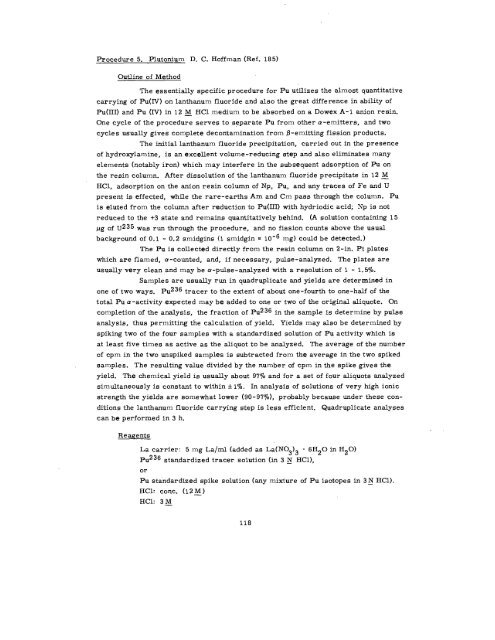THE RADIOCHEMISTRY OF PLUTONIUM - Sciencemadness.org
THE RADIOCHEMISTRY OF PLUTONIUM - Sciencemadness.org
THE RADIOCHEMISTRY OF PLUTONIUM - Sciencemadness.org
You also want an ePaper? Increase the reach of your titles
YUMPU automatically turns print PDFs into web optimized ePapers that Google loves.
Procedure 5. Plutonium D. C, Hoffman (Ref. 185)<br />
Outline of Method<br />
The essentially specific procedure for Pu utilizes the almost quantitative<br />
carrying of Pu(IV) on lanthanum fluoride and also the great difference in ability of<br />
Pu(III) and Pu (IV) in 12 ~ HC1 medium to be absorbed on a Dowex A-1 anion resin.<br />
One cycle of the procedure serves to separate Pu from other a-emitters, and two<br />
cycles usually gives complete decontamination from ~-emitting fission products.<br />
The initial lanthanum fluoride precipitation, carried out in the presence<br />
of hydroxylamine, is an excellent volume-reducing step and also eliminates many<br />
elements (notably iron) which may interfere in the subsequent adsorption of Pu on<br />
the resin column. After dissolution of the lanthanum fluoride precipitate in 12 ~<br />
HC1, adsorption on the anion resin column of Np, Pu, and any traces of Fe and U<br />
present is effected, while the rare-earths Am and Cm pass through the column. Pu<br />
is eluted from the column after reduction to Pu(IH) with hydriodic acid; NTP is not<br />
reduced to the +3 state and remains quantitatively behind. (A solution containing 15<br />
pg of U235 was run through the procedure, and no fission counts above tbe usual<br />
background of 0.1 - 0.2 smidgins (1 smidgin = 10-6 mg) could be detected. )<br />
The Pu is collected directly from the resin column on 2-in. Pt plates<br />
which are flamed, a-counted, and, if necessary, pulse-analyzed. The plates are<br />
usually very clean and may be a-pulse -analyzed with a resolution of 1 - 1. 5Y0.<br />
Samples are usually run in quadruplicate and yields are determined in<br />
one of two ways. PU236 tracer to the extent of about one-fourth to one-half of the<br />
total Pu @-activity expected may be added to one or two of the original aliquote. on<br />
completion of the analysis, the fraction of PU236 in the sample is determine by pulse<br />
analysis, thus permitting the calculation of yield. Yields may also be determined by<br />
spiking two of the four samples with a standardized solution of Pu activity which is<br />
at least five times as active as the aliquot to be analyzed. The average of the number<br />
of cpm in the two unspiked samples is subtracted from the average in the two spiked<br />
samples. The resulting value divided by the number of cpm in the spike gives the<br />
yield. The chemical yield is usually about 9’77. and for a set of four aliquots analyzed<br />
simultaneously is constant to within + 1%. In analysis of solutions of very high ionic<br />
strength the yields are somewhat lower (90-97yo), probably because ~der these con-<br />
ditions the lanthanum fluoride carrying step is less efficient. Quadruplicate analyses<br />
can be performed in 3 h,<br />
Reagents<br />
La carrier: 5 mg La/ml (added as La(N03)3 . 6H20 in H20)<br />
PU236 standardized tracer solution (in 3 ~ HC1),<br />
or<br />
Pu standardized spike solution (any mixture of Pu isotopes in 3 ~ HC1),<br />
HC1: cone. (12~)<br />
HC1: 3~<br />
118
















